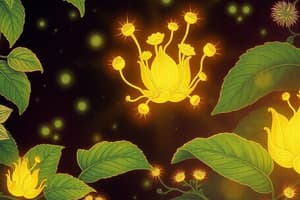Podcast
Questions and Answers
What are the major sites of photosynthesis in most plants?
What are the major sites of photosynthesis in most plants?
- Flowers
- Leaves (correct)
- Stems
- Roots
What are chloroplasts?
What are chloroplasts?
The sites of photosynthesis in plants.
What is mesophyll?
What is mesophyll?
The tissue in the interior of the leaf.
What do stromata do?
What do stromata do?
What is stroma?
What is stroma?
What is a thylakoid?
What is a thylakoid?
What is chlorophyll?
What is chlorophyll?
What does xylem do?
What does xylem do?
What is the function of phloem?
What is the function of phloem?
Flashcards are hidden until you start studying
Study Notes
Photosynthesis in Plants
- Leaves serve as the primary sites for photosynthesis in most plant species, utilizing sunlight to convert carbon dioxide and water into glucose and oxygen.
Chloroplasts
- Chloroplasts are the specialized organelles where photosynthesis takes place, located within the mesophyll cells of leaves.
Mesophyll
- Mesophyll is the internal layer of leaf tissue, rich in chloroplasts, playing a crucial role in photosynthetic activity.
Stromata
- Stomata are small openings on leaf surfaces that allow for gas exchange, enabling carbon dioxide to enter and oxygen to be released.
Stroma
- The stroma is the dense fluid within chloroplasts, surrounded by two membranes, and is essential for the photosynthetic process.
Thylakoids
- Thylakoids are membranous sacs located within the stroma, forming a separate space filled with fluid; they are critical for the light-dependent reactions of photosynthesis.
Chlorophyll
- Chlorophyll is a green pigment found in the thylakoid membranes; it absorbs light energy, which is essential for the photosynthetic process.
Xylem
- Xylem is the vascular tissue responsible for transporting water and essential nutrients from the roots upward through the plant.
Phloem
- Phloem is the vascular tissue that carries sugars produced in the leaves down to other parts of the plant for growth and storage, often converting excess sugar to starch.
Studying That Suits You
Use AI to generate personalized quizzes and flashcards to suit your learning preferences.




